How To Change Rear Brake Pads On A 2013 Ford Flex
Ford F-150 Rear Brake Pads Replacement Guide
How to change the rear disc brake pads on a 12th generation 2009-2014 Ford F150 truck with photo illustrated steps.
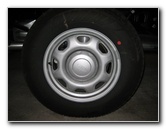
F-150 Rear Bike
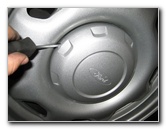
Pry Off Lug Nut Embrace
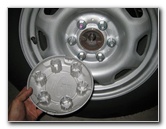
Hub Cap Removed
Owners of other F-Series trucks or other Ford, Lincoln and Mercury vehicles such every bit the Super Duty F-250, F-350, F-450, Expedition, Explorer, Edge, Escape, E-150, E-250, E-350, Transit Connect, Flex, MKX, MKT, Navigator and Mountaineer may also detect these DIY rear brake task instructions to be helpful.
The tools needed to complete this procedure include a flathead screwdriver, a lug nut wrench, a floor jack, two jack stands, a 13mm socket with ratcheting wrench, a "C" or "F" clamp, a new ready of rear brake pads and a packet of brake caliper lubricant.
A few uniform aftermarket restriction pads with their part numbers are every bit follow: Motorcraft BRF-1425, KFE KFE1602-104, Wagner QC1602, Wagner ZD1602, TRW TPC1602, Raybestos ATD1602C, ACDelco 17D1602CH, Akebono ProACT ACT1602, Power Finish (16-1602) Z16, Akebono ASP1602, Bendix D1602, Monroe CX1602, Bosch BE1602H, Dura International BP1602C and Bosch BE1602.
Please verify the correct replacement part numbers for your F-150 by checking the Amazon Function Finder website. The correct parts may vary depending on the model yr, trim level and whether it has the 4WD (four wheel drive) or RWD (rear wheel drive) transmission.
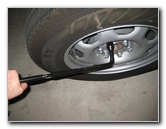
Loosen six Lug Nuts
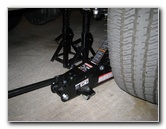
Raise Rear of Truck
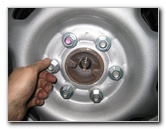
Spin Off 6 Lug Nuts
If your F150 is equipped with lug nut covers, gently pry off the cap with a flathead screwdriver to expose the six lug basics.
Slightly loosen the six lug nuts with the tire atomic number 26.
Raise the rear of the truck with the floor jack and securely back up it with at least two jack stands.
I adopt to work on 1 side of the vehicle at a fourth dimension for extra safety.
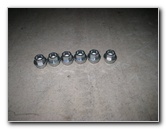
Half-dozen Lug Nuts Removed
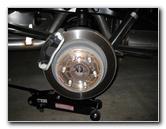
Rear Caliper, Subclass, Rotor
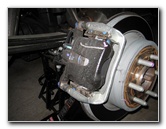
Rear Brake Caliper
Pull off the rear wheel to betrayal the rear brake caliper, bracket, rotor and suspension.
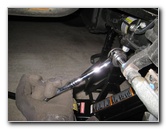
Loosen Lower 13mm Bolt
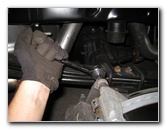
Loosen Upper Caliper Bolt
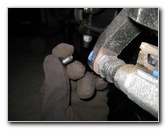
Remove Caliper Bolt
Loosen the two caliper bolts by turning them clockwise (as seen from the outside of the vehicle) with the 13mm socket and ratcheting wrench.
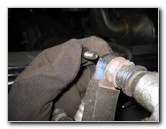
Remove Upper Bolt
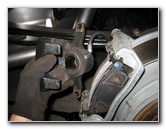
Pull Off Brake Caliper
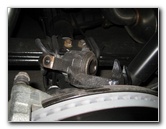
Rest Caliper On Break
Advisedly pull the rear brake caliper out of the bracket and off the old pads.
Securely residuum the caliper on the suspension or suspend it from the spring with a bungee cord or slice of rope.
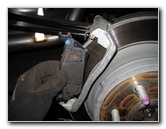
Remove Old Outer Pad
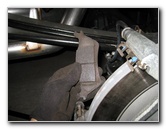
Pull Out Inner Pad
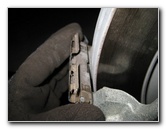
Supercede Anti-Rattle Clips
If your new set of rear brake pads came with new metal pad abutment or "anti-rattle" clips, pull the olds ane out of the top and bottom of the bracket before installing the new ones.
Thoroughly clean off the restriction rotor, caliper bracket, brake caliper associates and the lug nut studs with brake parts cleaner spray. Do non use compressed air or blow with your mouth to clean off the restriction parts since breathing in brake dust can exist harmful to your health. Brake grit can be carcinogenic (cancer causing) if inhaled.
![]() If your truck previously exhibited shuddering, pulsating, or vibrations during braking, you may need to take your rotors "turned" (resurfaced) or but supplant them with brand new rotors. If this is the truck's offset rear brake chore and the rotors appear to exist in excellent condition, yous should be able to just replace the pads with great results.
If your truck previously exhibited shuddering, pulsating, or vibrations during braking, you may need to take your rotors "turned" (resurfaced) or but supplant them with brand new rotors. If this is the truck's offset rear brake chore and the rotors appear to exist in excellent condition, yous should be able to just replace the pads with great results.
To remove the existing rotors and install new ones, only remove the 2 bolts on the rear of the caliper subclass that adhere it to the steering knuckle. Then loosen the one-time rotor with a safety mallet, pull it off, and slide the new one in its place.
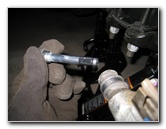
Remove Caliper Pins
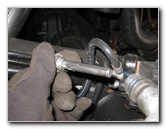
Lubricate & Replace Pins
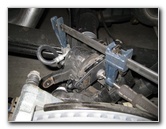
Attach "C" Clamp
Gently pull each caliper slider pin out of its rubber dust boot and utilize a thin layer of restriction caliper grease.
Push the caliper slider pins dorsum in identify until the rubber dust boot snaps in identify over the metallic lip.
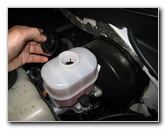
Remove Brake Fluid Cap
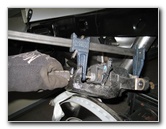
Shrink Caliper Piston
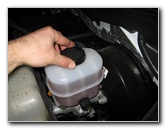
Supercede Brake Fluid Cap
Adhere the "C" clamp to the caliper piston using the back of an quondam brake pad to evenly distribute the strength.
Movement to the engine bay and twist off the brake fluid reservoir cap in the counter clockwise direction. Removing the brake fluid reservoir cap will let the brake fluid to more than easily travel backwards through the system when you compress the piston.
Slowly compress the caliper piston back until it is flush with its rubber dust boot. Try to avert pinching or otherwise damaging the rubber dust kick. Replace the brake fluid reservoir cap every bit soon as possible since brake fluid is hygroscopic (absorbs moisture).
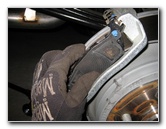
Install New Outer Pad
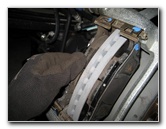
Install New Inner Pad
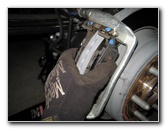
Push button Pads Against Rotor
Apply a thin layer of brake caliper grease to any place where metallic to metal contact takes place such equally the outer rings of the caliper piston. Do not apply lubricant to the friction surface of the new pads.
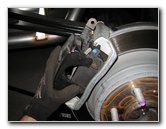
Supercede Rear Caliper
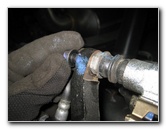
Thread In Upper Caliper Commodities
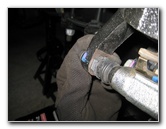
Insert Lower 13mm Bolt
If the caliper won't fit over the new pads, you may need to compress the caliper piston back a chip further.
Spin in the two caliper bolts by hand a few turns to prevent them from becoming cross threaded.
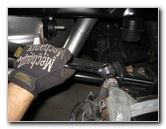
Tighten Upper Caliper Commodities
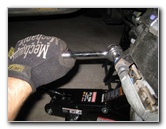
Tighten Lower 13mm Commodities
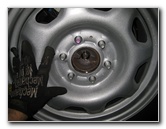
Replace Rear Cycle
Double cheque that both caliper bolts are tight before moving on to the next steps.
If your brake pedal previously felt soft or spongy, the brake fluid may exist contaminated with water or the restriction lines may comprise some air bubbles.
Information technology would be best to bleed the restriction lines at this time in order to flush out the old fluid and supervene upon information technology with fresh DOT3 restriction fluid. For more on this topic, check out my Brake Line Fluid Bleeding With An Assistant DIY Guide or alternatively the Brake Line Fluid Bleeding With A Power Bleeder Guide.
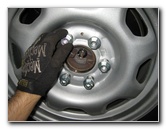
Spin On 6 Lug Nuts
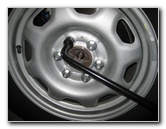
Slightly Tighten Lug Basics
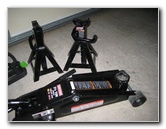
Lower Vehicle With Jack
Slightly tighten the lug nuts with the tire fe.
Lower the truck from the jack stands using the floor jack until the rear wheel holds plenty weight to keep it from spinning.
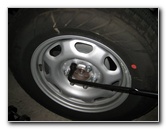
Torque Lug Nuts
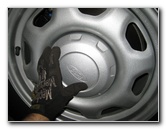
Replace Center Cap
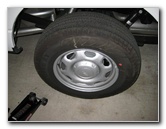
Rear Brake Pads Replaced
Progressively tighten the 6 lug nuts in a "criss cantankerous" or "star" pattern to about 1/4 to 1/3 plough past hand tight. It would be best to use a torque wrench or an impact wrench with a torque stick to tighten the lug nuts to about 150 ft lbs of torque.
Sit in the driver's seat of the vehicle and pump the brake pedal a few times to restore the brake line pressure. Bank check the brake fluid in the reservoir and verify that it is at the proper level. If it is low, add together some DOT 3 fluid.
Have the truck for a quick test drive and so double bank check that the lug nuts are properly tightened.
To break in your new rear restriction pads, just bulldoze ordinarily for the first several hundred miles while trying to avoid any difficult or "panic" stops which may glaze over the new pads and cause them to be noisy and/or non perform besides.
Information technology's also a adept idea to regularly bank check your driveway for drops of brake fluid which may indicate a leak, check the brake fluid level in the reservoir, and also verify that the lug nuts are notwithstanding tight.
For more, check out my other Ford F-150 Repair & Maintenance Guides.
Source: https://www.paulstravelpictures.com/Ford-F150-Rear-Brake-Pads-Replacement-Guide/
Posted by: pickettofeautioull.blogspot.com

0 Response to "How To Change Rear Brake Pads On A 2013 Ford Flex"
Post a Comment